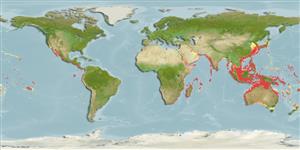Common names from other countries
分类 / Names
俗名 | 同种异名 | Catalog of Fishes(属, 种) | ITIS | CoL | WoRMS | Cloffa
Teleostei >
Scombriformes (Mackerels) >
Scombridae (Mackerels, tunas, bonitos) > Scombrinae
Etymology: Sarda: Latin and Greek, sarda = sardine; name related to the island of Sardinia (Ref. 45335).
More on authors: Temminck & Schlegel.
Environment: milieu / climate zone / depth range / distribution range
生态学
海洋; 海洋洄游的 (Ref. 51243); 深度上下限 1 - 167 m (Ref. 58302). 亞熱帶的; 14°C - 23°C (Ref. 168); 43°N - 41°S, 24°E - 77°W (Ref. 168)
Indo-Pacific: widespread but with many gaps in its known distribution. Eastern Pacific: Hawaiian Islands and Pacific coast of USA to southern tip of Baja California and Tres Marias Islands extending to Cabo Blanco, Peru (especially during El Niño events), the Galapagos Islands and Gulf of Guayaquil.
印度-太平洋: 廣泛分佈在它已知的分佈中但是有許多間隙。 東太平洋: 夏威夷群島與美國的太平洋海岸到下加利福尼亞的最南端與三瑪麗亞島延伸至祕魯的卡玻布蘭科 (尤其在聖嬰現象事件時), 加拉巴哥群島與惠夜基灣。
Length at first maturity / 大小 / 重量 / 年龄
Maturity: Lm 47.8, range 45 - ? cm
Max length : 102 cm FL 雄鱼/尚未辨别雌雄; (Ref. 9684); common length : 55.0 cm TL 雄鱼/尚未辨别雌雄; (Ref. 55763); 最大体重: 10.7 kg (Ref. 168)
背棘 (总数) : 17 - 19; 臀棘: 0; 臀鳍软条: 14 - 16; 脊椎骨: 44 - 45. Mouth moderately large. Laminae of olfactory rosette 21 to 39. Interpelvic process small and bifid. Body completely covered with very small scales posterior to the corselet. Swim bladder absent. Spleen large and prominent in ventral view. Liver with elongate left and right lobes and a short middle lobe. Back with narrow oblique stripes.
嘴普通大的。 嗅觉毛簇的叶片 21 到 39. 腹鳍间的突起小而两裂的。 身体完全地覆盖着了最小鳞片在甲胄后面。 泳鳔不存在。 脾脏大而突出的由腹面观之。 肝脏有细长的左边与右边的叶与一个短的中央叶。 背面有狭窄的斜斑纹。
A coastal species (Ref. 9340) found schooling with small tunas. Also found around some islands (Ref. 9684). Feeds on clupeoids, other fishes, squids and decapod crustaceans. Spawning varies with the monsoon season (Ref. 9684). Also caught with troll lines, encircling nets (Ref. 9340) and drift nets (Ref. 9684). Marketed mainly fresh; also dried-salted (Ref. 9684), canned and frozen (Ref. 9987).
被发现与小的鲔鱼聚集成群的一个沿岸鱼种 (参考文献 9340)。 也一些岛的周围发现。 (参考文献 9684) 吃鲱鱼, 其他的鱼,乌贼与十足目甲壳动物。 产卵随着雨季改变。 (参考文献 9684) 也用延绳钓,围网 (参考文献 9340) 与流网捕获。 (参考文献 9684) 生鲜地主要地在市场上销售; 也乾燥盐腌 (参考文献 9684), 罐装及冷冻.(参考文献 9987)
印度-太平洋: 廣泛分佈在它已知的分佈中但是有許多間隙。 東太平洋: 夏威夷群島與美國的太平洋海岸到下加利福尼亞的最南端與三瑪麗亞島延伸至祕魯的卡玻布蘭科 (尤其在聖嬰現象事件時), 加拉巴哥群島與惠夜基灣。
Collette, B.B. and C.E. Nauen, 1983. FAO Species Catalogue. Vol. 2. Scombrids of the world. An annotated and illustrated catalogue of tunas, mackerels, bonitos and related species known to date. Rome: FAO. FAO Fish. Synop. 125(2):137 p. (Ref. 168)
CITES (Ref. 128078)
Not Evaluated
人类利用
渔业: 低经济; 游钓鱼种: 是的
工具
特别资料
下载 XML
网络资源
Estimates based on models
Preferred temperature (Ref.
115969): 20.5 - 29, mean 27.6 (based on 2552 cells).
Phylogenetic diversity index (Ref.
82804): PD
50 = 0.5312 [Uniqueness, from 0.5 = low to 2.0 = high].
Bayesian length-weight: a=0.01000 (0.00520 - 0.01924), b=3.05 (2.89 - 3.21), in cm Total Length, based on LWR estimates for this species & (Sub)family-body (Ref.
93245).
营养阶层 (Ref.
69278): 4.2 ±0.66 se; based on food items.
回复力 (Ref.
120179): 中等的, 族群倍增时间最少 1.4 - 4.4年 (Assuming tm=3-4).
Fishing Vulnerability (Ref.
59153): Moderate vulnerability (35 of 100).
Climate Vulnerability (Ref.
125649): High vulnerability (59 of 100).
